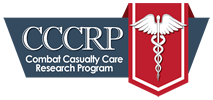The Combat Casualty Care Research Program is organized into eight research portfolios, each of which combines the work of several subordinate task areas into a comprehensive, refined effort to provide medical solutions for combat and trauma care.
Improve hemorrhage control, resuscitation following combat related injury, and the treatment of acute battlefield pain.
Develop solutions related to modeling, triage, diagnosis, patient management and treatment for injuries combining trauma with CBRN exposures. The program also focuses on the development of medical countermeasures (MCMs) for acute radiation syndrome (ARS).
Optimize patient outcomes and operational advantage by developing methods for increasing the timing and volume of patient moved throughout the continuum of care.
Develop advanced technologies systems that are integrated and intelligent, to include advanced monitoring and autonomous care platforms that optimize the care of combat casualties throughout the continuum of care.
The Sustainment of Expeditionary Medical Skills (SEMS) portfolio focuses on optimizing learning effectives, boosting training efficiency, and development methods that increase skills permanency across the continuum of care.
The goal of the Traumatic Brian Injury Portfolio is to close military-relevant gaps in combat-related Traumatic Brain Injury (TBI) from the battlefield through acute hospitalization.
Drive medical innovation addressing military-relevant gaps across the spectrum of trauma care from point of prehospital physiologic stabilization to more definitive care located outside the theatre of operations.
Develop tailored solutions that accelerate healing, restore structure, restore function, and provide holistic care, ensuring wounded soldiers will receive the best possible outcomes after injury.
Conduct preclinical and translational Research and Development (R&D) to deliver advanced, easy to use, drugs, devices, and clinical practice guidelines to reduce mortality, accelerate Warfighter return to duty, improve long-term functional recovery and quality of life outcomes following burn trauma.
